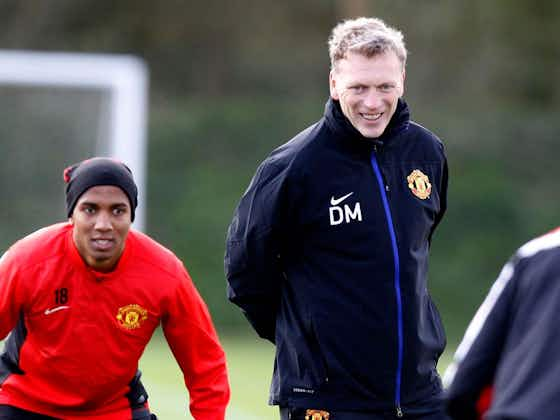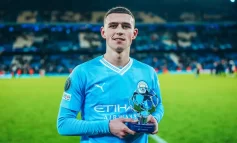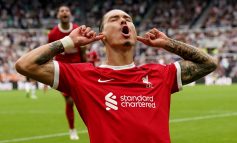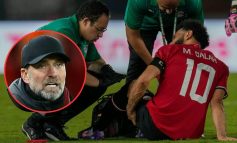THIS IS A LOW: EACH PREMIER LEAGUE TEAM’S WORST SEASON AS MAN UNITED THREATEN THEIRS

David Moyes was not a success at Manchester United
“If you can’t handle me at my worst, then you sure as hell don’t deserve me at my best.”
We’ll perhaps never truly know whether Marilyn Monroe was thinking about the 21st century low points of the 20 current Premier League clubs when she uttered those famous words. But let’s just imagine she was. Here, then, are the Marilyn-at-her-worst seasons you had to handle to enjoy the glorious title-winning campaigns or that time you nearly qualified for the Europa or finished comfortable and stress-free in mid-table. Are we only doing this because Manchester United are currently a bit rubbish? We prefer not to speak.
And we’re not getting into the whole ‘Actually, the year 2000 is in the 20th century’ nerd-off. We’re starting from the 2000/01 season here because we are. Okay? Good. Let’s crack on.
What’s the story? Arsenal hadn’t finished outside the top six since 1994/95, the season when the George Graham bungs scandal broke. It became a banter in the end, but Arsenal finished inside the top four every season from 1996/97 until 2016/17; that Wenger top-four run really was something, but he did also leave a mess in his wake. His final season they were sixth and a bit poo and things continued generally downhill for a few years after that as first Unai Emery came in and didn’t last long in what appears to be a necessary sacrifice after any legendary long-term manager shuffles off. Then came the Mikel Arteta Process, which is both the name of a shit nauseatingly self-referential and knowing indie band circa 2006 and also, for a couple of years, a really quite shit football team. Arsenal finished a lowly eighth two years running, but the second of those gets the nod here because in 2019/20 they did win the FA Cup.
What happened next? Arsenal started making good, sensible signings instead of bad, chaotic ones. A bold strategy which they’ve stuck with and which seems to be working really rather well.
The next season: 5th in the Premier League, self-bantered out of the Champions League places by their own cunning and, particularly gallingly, Spurs. But it was already clearly much, much better. Even if nobody quite had it down as “nearly winning the title” better. Fell well short of that in the end as April and May took their toll but were still comfortably the second best team in the country and little evidence a great deal has changed this season despite early signs of improvement from your Liverpools and Tottenhams.
Aston Villa
The season: 2016/17, 13th in the Championship
What’s the story? Having lost their ever-present Premier League status the year before, Villa made a disastrous start to life in the Championship. Roberto Di Matteo was sacked in October after one win in 11 games with Steve Bruce coming in for a classic British Manager firefighting gig. Seven wins in the next 12 did precisely that before a run of seven defeats in eight put paid to any fanciful thoughts of a late play-off push. A funny old season really.
What happened next? John bloody Terry rocked up and was immediately appointed Captain, Leader, Legend.
The next season: 4th in the Championship and 1-0 play-off final defeat to Fulham.
Bournemouth
The season: 2008/09, 21st in League Two
What’s the story? After going into administration and being relegated from League One, Bournemouth very nearly weren’t even allowed to start the League Two season owing to fears over their ability to fulfil their fixtures. They eventually did so with a 17-point penalty. Thirty-one-year-old Eddie Howe took over as manager with the club still 10 points adrift at the bottom of the table. They secured their Football League status with a 2-1 win over Grimsby in the final home game of the season.
What happened next? The Adam Murry and Jeff Mostyn consortium finally took control of the club in June. Howe’s team won eight of their first nine games of the 2009/10 season.
The next season: 2nd in League Two, promotion and the start of everything remarkable that has happened at the club since.
Brentford
The season: 2007/08, 14th in League Two
What’s the story? After relegation from League One, Brentford faced the very real prospect of sliding out of the bottom of the league altogether under new manager Terry Butcher. Five defeats in six games in September and October raised alarm, five consecutive defeats in November and December without so much as a goal scored meant full panic stations. Butcher survived a 7-0 defeat at Peterborough in the middle of that run but two further defeats led to a by now pretty much inevitable mutual consenting and the promotion of his assistant, former Bees player Andy Scott. A run of eight wins in 12 games followed to end the relegation fears, but the season stalled once they were safe and 10 of the last 15 games of the season were lost.
What happened next? Scott signed a new permanent deal before the end of the 2007/08 season and then brought in 12 players in the summer, eight of them permanents and most notably striker Charlie MacDonald from Southend, who would go on to top-score in a title-winning campaign. Jordan Rhodes was a canny January loan pick-up as well, his seven goals in 14 games helping Brentford emerge from a congested top-of-the-table pack to ultimately win the division by six points.
The next season:
Brighton
The season: 2000/01, 1st in Division Three
What’s the story? Not quite Bournemouth levels, but not far off. Brighton’s unlikely and lengthy journey from the bottom tier and financial strife to the Premier League top six burst into life at the start of the century with a Bobby Zamora-inspired romp to the title in Division Three – which for any youngsters reading is what they used to call the Fourth Division before it was League Two – helped in part by a nine-point deduction for Chesterfield which dropped the Spireites from second to third.
What happened next? A Bobby Zamora-inspired romp to the title in Division Two – which for any youngsters reading is what they used to call the Third Division before it was League One.
The next season: 1st in Division Two – which for any youngsters reading is etc.
Burnley
The season: 2003/04, 19th in Division One
What’s the story: Burnley had a couple of dicey Division One/Championship seasons before doing assorted Premier League bits, but never came closer to a trip to the third tier than under Stan Ternent in 2003/04. A year-long struggle ended with the Clarets in 19th and just two points above the relegation zone with the team’s lack of defensive nous a constant problem. They conceded 77 goals, a total exceeded only by bottom-club Wimbledon in their division while Notts County in Division Two were the only other side across the whole Football League to ship more goals.
What happened next? Steve Cotterill replaced Ternent in the summer and the following year was one of tentative if demonstrable improvement, most notably in the defending. They still scored only 38 goals in 46 games but cut the goals conceded almost in half to 39 and landed mid-table in the newly rebadged Championship, a point behind Stoke and level on points with Leeds.
The next season: 13th in the Championship.
The season: 2022/23, 12th in the Premier League
What’s the story? A quite astonishing banter of a season, from a club that had already produced one such season in recent memory. Chelsea’s list of finishing positions in the last 10 seasons really is quite something now, containing two title wins, three third-place finishes, a couple of fourths, a fifth and also a 10th and now a 12th. In the modern Premier League it’s an extraordinary level of mixed-baggery. And you can go back further to mark those two bad seasons out as even more eye-catching, because they are Chelsea’s only finishes outside the top six since 1995/96. The 2015/16 Mourinho-instigated collapse was followed by an extraordinary title win the following year under Antonio Conte. The 2022/23 Tuchel-Boehly-instigated collapse appears unlikely to be followed by an extraordinary title win this year.
What happened next? Such is Chelsea’s miserably drab current brand in which they are apparently intent on seeing not just how bad a billion-pound team can be but also far more damningly how boring, that they’ve once again spent absolute fortunes on players, brought in a manager previously beloved of one of their fiercest rivals, are shit, are 14th in the league, are playing dreary and ineffective football and yet can’t even manage to get themselves ordained as the official Big Six Crisis Club. They should be in full cracked badge territory right now, but honestly who can even be arsed to fire up the Photoshop?
The next season: Time will tell, but currently 14th with five points from five games in which they’ve scored five goals and conceded five goals. Low fives all round.
Crystal Palace
The season: 2009/10, 21st in the Championship
What’s the story? Another tale of financial woe, with Palace entering administration in January – taking a 10-point penalty in the process – and losing manager Neil Warnock a month later. Paul Hart came in and helped Palace to scramble to safety, which wasn’t secured until the final day of the season.
What happened next? The Steve Parish-led CPFC 2010 consortium completed their takeover and put George Burley in charge. On-field results were actually even worse than the previous year, with Burley replaced by his assistant Dougie Freedman in January. A 10-point penalty in this season would’ve meant relegation. But instead…
The next season: 20th in the Championship
Everton
The season: 2022/23, 17th in the Premier League
What’s the story? Everton have finished one place above the Premier League trapdoor three times altogether and twice this century. In 2003/04 under David Moyes, proved to be a significant but undeniable blip. A mere bump in the road between seventh-place and memorably fourth-placed finishes for a club that spent much of the decade after the 03/04 near miss in and around the top six. It also wasn’t really that near of a near miss, with the three teams below them all six points adrift in the final reckoning. It was nervous glance over the shoulder stuff rather than full on relegation doom and despair angst.
This was very much not the case in 2022/23, a season in which Everton for the second year running dispensed with their manager right at the end of the January transfer window as relegation fears grew, and ultimately only survived thanks to a fraught 1-0 win over Bournemouth on the final day. Their final tally of 36 points was three points worse than their two previous 17th-place finishes in a 20-team Premier League and thus the first time they’d failed to even manage a point per game. Sean Dyche came in to put out the fires Frank Lampard had left raging, and just about did enough, but good lord they were drab. Even with an inexplicable and vital 5-1 win at Brighton late in the season, they still scored fewer goals than any team in the division other than Wolves and their top scorer, Dwight McNeil, managed just seven in all competitions.
What happened next? They’re not finishing fourth this time. A third straight desperate and grim battle to preserve at all costs a proud unbroken run of top-flight football is on the cards, and it is only the even more conspicuous strife currently enveloping others that makes you think Everton will, once again, be just about fine.
The next season: Currently more of the same as Dyche’s team sit 18th with one point and a division-low two goals from their five games thus far.
Fulham
The season: 2015/16, 20th in the Championship
What’s the story? You sort of feel that Fulham must have had at least one blip that took them to League One this century but you would be wrong. They only nearly sunk that far in a farcical 2015/16 season where they had four different managers before December was out. Kit Symons started the season in charge having replaced Felix Magath and kept the Cottagers up the previous season. He lasted until November, when back-to-back defeats to Burnley and Birmingham left Fulham in what would turn out to be a quite lofty mid-table position. Next came a caretaker stint for Peter Grant, which went so badly he was also replaced, by Stuart Gray. Fulham won zero games while this was all going on. Then Slavisa Jokanovic was announced as manager on December 27, and before he even officially took over Fulham actually did manage a win, against Rotherham on December 29. Jokanovic formally took the reins on December 30 and immediately presided over a five-match winless run. By March, Fulham were 21st and really in the shit, but three straight wins in the first nine days of April against MK Dons, Preston and Cardiff settled the nerves and they ended the season two places but 11 points above the bottom three.
What happened next? Decided to stick with just the one manager for 2016/17 and almost got promoted.
The next season: 6th in the Championship, losing 2-1 on aggregate to Reading in the play-off semi-final.
Liverpool
The season: 2011/12, 8th in the Premier League
What’s the story? Liverpool have slipped as low as eighth in the final table twice this century, but the second time they did it in 2016 they got 60 points which isn’t great but also not entirely disgraceful. In 2012, they managed a mere 52. Which is a lot worse, isn’t it? It was also the season of Luis Suarez’s cultural differences with Patrice Evra and Liverpool’s shameful response to it all. Which is definitely worse. Nonetheless, Kenny Dalglish’s side actually started the season reasonably well despite a wild 4-0 defeat at Spurs in September. At the turn of the year they had lost just once in 14 league games since that thrashing and were an upwardly mobile sixth still very much in Champions League contention despite the fact Suarez was now serving an eight-match ban. They lost 11 of their remaining 19 games. But did win the League Cup, so that’s something.
What happened next? Dalglish was out, Brendan Rodgers was in, as were Fabio Borini and Joe Allen. We all know how the B-Rodge Liverpool story played out, but initial progress was slow. Five games without a win at the start of the season actually saw Liverpool briefly in the drop zone before things slowly fell into place – most notably in the new year with the arrivals of Daniel Sturridge and Philippe Coutinho.
The next season: 7th in the Premier League
Luton Town
The season: 2012/13, 7th in Conference Premier
What’s the story? That really is extraordinary. Not just for being non-league but for being so recent. Ten years ago, current Premier League team Luton weren’t just in non-league, but were off the pace in non-league. The 2012/13 season was the fourth of their five years spent outside the League, and comfortably their worst. Seventh isn’t great anyway, but tells only half the story. They were 13 points adrift of the play-offs in the end, and that was with the gloss applied by a run of three wins and two draws in the last five games of the season. As late as April they were as low as 12th in the table after a 5-1 defeat at Gateshead.
What happened next? John Still, who had taken over from Paul Buckle the previous February, oversaw a promotion campaign that started slowly but soon became unstoppable. Luton won only two of their first eight games of the season, but after a 2-0 defeat at Wrexham (whatever happened to them?) in September, they wouldn’t lose another game until March after a 27-game unbeaten run that had taken them to a near impenetrable position at the top of the table. They racked up 101 points and finished 19 clear of nearest rivals Cambridge United to start a journey that has taken the Hatters all the way back to the top flight.
The next season: 1st in the Conference Premier
Manchester City
The season: 2001/02, 1st in Division One
What’s the story? Having secured back-to-back promotions to the Premier League from Division Two, City slipped back into the second tier with relegation in 2000/01. They spent the following season under Kevin Keegan doing to the Championship what their future cash-rich sides would do to the Premier League. City successfully fed the Goat to rack up 99 points and 108 goals to smash their way back into the top flight, where they have remained ever since.
What happened next? Quaint as it is to think of City smashing their transfer record with a £13million signing, bringing Nicolas Anelka back to England from PSG was something of a coup, while Sylvain Distin also made the same move for another £5m. Peter Schmeichel arrived on a free from Villa. It all went pretty well – City not only got a first win in ages against Manchester United and finished in the top half but also sneaked into Europe via the Fair Play League.
Manchester United
What’s the story? David Moyes. It’s all very easy – and also fun – to laugh at the extent to which Manchester United fans lost their minds when confronted with a mediocre team playing mediocre football under a mediocre manager in a mediocre league position, but you really have to consider the context. There was a whole generation of United fans for whom the worst-case unthinkable disaster season was the one time they finished below both Arsenal and Chelsea and didn’t even win a cup to make up for it. The rest of us had either seen plenty of these Moyesy seasons before – or dreamed of such riches. Not so for United fans, bless ‘em. At the time, it was United’s first Premier League finish outside the top three. Even now after a decade of often startling (if relative mediocrity) it remains Manchester United’s solitary trip outside a top-six finishing position in the Premier League era. Which does all serve to put the start they’ve made this season into some important context. We could well be watching the worst United side of the Barclays Age by a startling margin.
What happened next? Moyes got the boot in April and they gave it Giggsy until end of the season, then Louis van Gaal came along and, if anything, played even worse if less disastrous football than Moyes. With Van Gaal followed by a classic three-year destroy-and-exit from Jose Mourinho and the doomed perpetual corner-turning one-step-forward two-step-backing of the Ole Gunnar Solskjaer, it was only really last season – almost a decade later – that some kind of normality appeared to be restored by Erik Ten Hag. How’s that going?
The next season: 4th in the Premier League
Newcastle
The season: 2016/17, 1st in the Championship
What’s the story? Really should have thought about this format a bit more carefully. Maths may say 21st in the league pyramid is worse than 18th, but in the wider context it isn’t really, is it? Anyway. Newcastle have managed to get themselves relegated twice this century, which is a touch careless of them really. However, credit where it’s due, they have made minimal fuss of bouncing straight back both times which has conspicuously not been the case for assorted other big clubs who’ve stumbled through the trapdoor and been doomed to years or even decades deluding themselves they are a ‘Premier League club in all but name’ and trying to salve their wounds by turning up in your dad’s list of who should be in a ‘Proper Premier League’. But that fate never befell Newcastle, whose two Championship seasons were both pretty much faultless. In 2017, however, they only managed to win the second tier with a shameful 94 points rather than the 102 they had managed seven years earlier. Rafa Benitez, who had come in too late to save them in 2015/16, stayed on in the Championship to secure his Toon Legend status.
What happened next? A run of eight defeats in nine games between October and December threatened to leave Newcastle in another relegation fight but they eased their way up to mid-table in the end.
The next season: 10th in the Premier League
Nottingham Forest
The season: 2005/06, 7th in League One
What’s the story? Five defeats in the first seven games of the season raised the horrifying prospect of the two-time European Champions dropping into the fourth tier of English football under Gary Megson, but a five-match unbeaten run to follow that dragged them back to the merely humiliating mid-table. Another grim run in the new year, losing four games in five, ultimately cost Megson his job and left Forest with an uphill battle to reach the play-offs. Eight wins and two draws in the next 10 saw much of that mountain conquered only for Forest to slip again in the final three winless games to finish two points outside the top six and stuck in League One for another year.
What happened next? Colin Calderwood’s side made it to the play-offs. But…
The next season: 4th in League One, lost 7-4 on aggregate to Yeovil in a play-off semi-final. Forest led 3-1 on aggregate with 10 minutes of the second leg remaining, but conceded in the 82nd and 87th minutes. And then the 92nd and 109th as well.
Sheffield United
The season: 2015/16, 11th in League One
What’s the story? After a season in the Premier League in 2006/07, the Blades found themselves down to the third tier just four years later and would remain stuck there for six seasons. As so often seems to be the case, things are darkest for fallen giants just before the dawn as Nigel Adkins’ side spent almost the whole season treading mid-table water despite what would prove to be a deceptive four-game winning run in August putting them among the division’s early pacesetters. They ended up 11th sandwiched between Rochdale and Port Vale.
What happened next? In came Chris Wilder and, propelled by Billy Sharp’s 30 goals, the Blades did the previous season in reverse. Having won four of their first five before flatlining, Wilder’s United took the far more successful approach of losing three of their first four but then losing only another three of the remaining 43 to win the division by 14 points and crack the century mark.
The next season: 1st in League One
Tottenham
The season: 2003/04, 14th in the Premier League
What’s the story? Spurs signed Helder Postiga, Bobby Zamora and Mbulelo Mabizela. Glenn Hoddle didn’t make it past September. They were woeful as – it’s sometimes easy to forget – they mainly were for the first decade or more of the Premier League. Anyway. David Pleat came in as caretaker manager and, crucially, Jermain Defoe was signed in February. Despite arriving with only 15 games of the season remaining, Defoe ended it as Spurs’ second-highest scorer. A run of five wins in six during January and February was ultimately what saved Spurs from a real relegation scrap.
What happened next? Spurs appointed Jacques Santini as manager. It started well enough, with just one defeat – and that to Manchester United – in the first seven games. Spurs then lost their next six, Santini walking away to be replaced by his assistant, Martin Jol, after four of them. Jol’s first game was a nonsense 5-4 north London derby defeat to Arsenal but he soon had them on a five-match winning run and dreaming of Europe. That, it turned out, would have to wait until the following season.
The next season: 9th in the Premier League
West Ham
The season: 2003/04, 4th in the Championship
What’s the story? Actually finished two places lower the following year, but as they won the play-offs rather than losing 1-0 to Crystal Palace in the final you’d have to say that’s a better season overall. A post-relegation exodus decimated the squad, but Jermain Defoe’s transfer request was denied and he would spend the first half of the season still at Upton Park (see Tottenham above). When he did leave, the Hammers got Bobby Zamora in return. Defoe nevertheless ended the season as West Ham’s second highest league scorer of the season just as he did at Spurs. Not a bad effort.
What happened next? West Ham signed Teddy Sheringham on one of the shrewdest free transfers going. He scored 20 goals as the Hammers finished the season sprinting to sneak into the play-offs where they defeated Ipswich and then Preston.
Wolves
What’s the story? Having nailed the old double relegation trick, Wolves pulled out of the tailspin to get themselves back into the Championship at the first time of asking thanks to another one of those 100+ point seasons that technically counts as a team’s worst of the century.
What happened next? Intense ruing of a five-match losing run in November and December as Wolves missed out on the chance of following back-to-back relegations with back-to-back promotions, finishing outside the play-off places only on goal difference.




